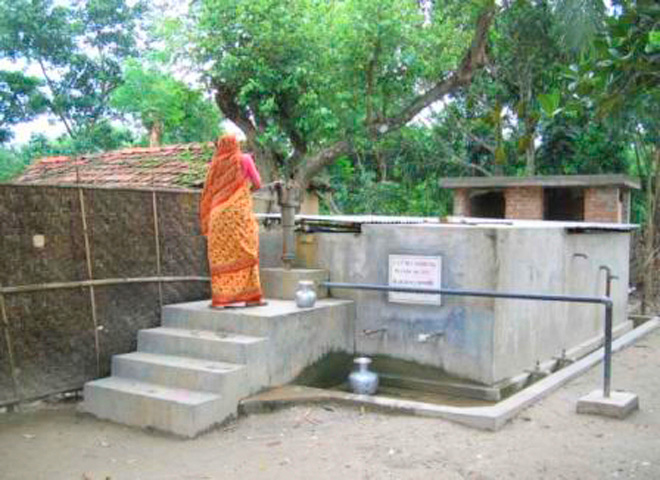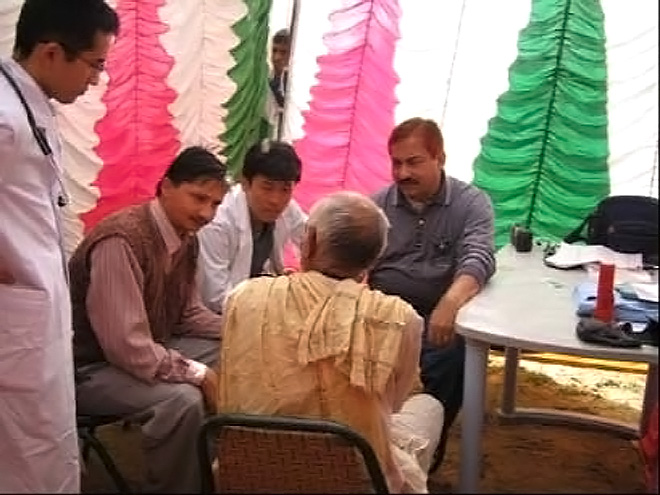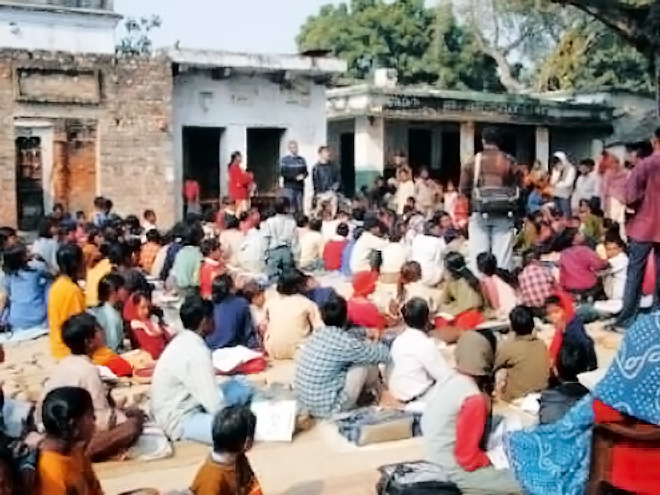Intl Cooperation
Arsenic Mitigation Projects in Ganges Basin
Since 1996, UOM has performed a lot of surveys and mitigation measures at the arsenic affected areas at Ganges basin in Bangladesh, Nepal and India.
In Bangladesh we have developed and installed arsenic-safe water supply systems from 1997 to 2003.
Fig.1 shows an arsenic removal unit (Gravel Sand Filter: GSF). Many GSFs are now installed in Bangladesh by the JICA Project.
Fig.2 shows a medical examination at the model village in Nepal, where we have studied arsenic contamination from 2002 to 2004. The arsenic contamination ratio of tube wells in the village was 95% and 5 deep tube wells were installed there by us for the purpose of creating an arsenic safe water supply.
Fig.3 shows a professor of UOM teaching a pupil about the dangers of arsenic at the school grounds in Uttar Pradesh state of India, where we surveyed from 2006. JICA/UOM arsenic mitigation project will start from 2008 based on the survey results from 2006 to 2007.

Fig.1 Arsenic Removal Unit (Gravel Sand Filter: GSF) installed in Bangladesh

Fig.2 Medical examination at a highly contaminated arsenic village in Nepal

Fig.3 Teaching pupils about the danger of arsenic in Uttar Pradesh state of India
JICA Training Course in Reinforcement of Public Administration and Community Partnership for Reproductive Health
Outline
Since 1990, global progress in reducing child and maternal deaths has been significant. The estimated annual number of under-five deaths has fallen from 12.6 million to 6.6 million, and the annual maternal mortality number has fallen from 540,000 to 280,000. Despite these gains, child and mother survival remains an urgent concern. Over two-thirds of child and maternal deaths occur in developing countries. Most are from preventable causes such as infectious diseases (due to poverty, lack of nutrition, and poor access to safe drinking water and sanitary facilities), insufficient personnel in the medical and health services, and ineffective referral systems between medical institutions. Since 2007, UOM has started Japan International Cooperation Agency (JICA) training course, which is designed for national/local government personnel along with NGO staff who are in charge of maternal and child health or women's health. The course has been modified to emphasize community partnership for reproductive health from 2013. Target countries are Afghanistan, Armenia , Ethiopia, Liberia, Myanmar, Philippines, Sudan, and Timor-Leste. The course is a four-week program, and the maximum number of participants is limited to ten. The main aim of this training course is to foster a basic understanding on the Japanese system and policies in the field of maternal and child health care with a view to improve the health status of women.
Contents of the Course
The course holds in cooperation with various organizations such as Miyazaki's prefectural and city governments, the Midwives'Association, the Nursing Association, and nonprofit organizations. Participants are given opportunity of observing the support systems of maternal and child health, perinatal medicine, child abuse and domestic violence, and other activities for women's health in Miyazaki. They also learn by joining several volunteer organizations' activities that support mothers and children and the Parent-Teacher Association (PTA) for junior high school students. Participants are provided training in exercise for pregnant and postpartum women , and in developing health education materials. The course integrates with many observation programs in order to offer actual situations and activities in Miyazaki, through visits of many facilities such as a maternity home, a hospital, schools, and a health center. It has also collaborated with ENP (English for Nursing Purposes) program. The participants and students discuss their health care systems and cultures. There are many exchange programs among participants, students, and university staff. At the end of the course, each participant is prepares a report including their own action plans for execution back home and to make an oral presentation.
Technical Training Program for Japanese Descendants
There are now thought to be more than 2.6 million Japanese emigrants and
their descendants (Nikkei) living abroad and they are now playing key roles
in their countries' development in various fields. Their presence has helped
build trust in Japanese people and closer bilateral relationships, and
thus they are now important partners in international cooperation. From
this point of view, Japan International Cooperation Agency (JICA) disseminates
knowledge to deepen the Japanese public's understanding of Japanese emigration
and Nikkei communities, and also supports Japanese emigrants and their
descendants by offering assistance programs.
With the cooperation of JICA, Division of Plant Production Science, Faculty of Agriculture, offers the technical training program of advanced technology and research from crop production to plant protection, focusing on sustainable and ecologically safe agriculture, and receives Nikkei training participants for one year course continuously.
The purpose of the program is the training of leaders, and to develop cultivation techniques, based on plant physiology and ecologically-based integrated crop management (ICM) with landscape management, are taught practically in cooperation with research stations and farmers, as well as lectures. Several study tours are also performed in order to attend the academic conferences and to study Japanese culture.
Research Work in Science Education between Japan and Ghana at UOM
Every 4 years, IEA (International Association for the Evaluation of Educational Achievement) conducts a science and math test in OECD (Organization for Economic Co-operation and Development) member countries and compiles the results. Students in both grades 4 and 8 take part in the exams.
The purpose is about taking a look at the TIMSS2003 (Trends in International Mathematics and Science Study) results and how best Ghana, whose results were below average, can be helped to improve upon subsequent performances with the view point of one of the high performing countries like Japan.
The performance of a country's students in scientific subjects may have implications for the part that country will play in tomorrow's advanced technology sector. Science, math, and technology play a very important role in providing solutions to major challenges or social problems. According to the Programme for International Student Assessment (PISA), the definition of scientific literacy is based on 3 dimensions; namely scientific knowledge or concepts, scientific processes, and the situations in which the knowledge and processes are assessed.
The scientific process aspect is getting less attention than other subjects in junior high school in Ghana and it is when the students master the act of conducting experiments and carrying out investigations that they will apply what they have learned into solving problems.
Studies on the Japanese science lesson structure, and observations on the conduction of science experiments in the University's attachment school will be the main activities to be undertaken during this research.
I hope to learn how best science can be taught in both the primary and junior high schools with emphasis on the best methodology to use.
The national curriculum for science at junior high school should be reviewed to emphasize the investigative and problem-solving aspects of the subject, especially the very act of conducting experiments. Therefore, there will be enhanced performance in subsequent TIMSS results.
Linkage Master Programs between Indonesian Universities
UOM and the National Development Planning Agency of Indonesia (BAPPENAS) have agreed to collaborate in the Linkage Master Programs (LP) for the Participants of the Professional Human Resource Development Project Phase Ⅲ (PHRDP-Ⅲ), for local government officials, funded by the Japan Bank for International Cooperation (JBIC) Loan in 2007. According to this agreement, UOM will accept LP students from the School of Architecture, Planning and Policy Development of the Institut Teknologi Bandung (SAPPK-ITB) and Faculty of Engineering of the Universitas Gadjah Mada (FT-UGM) into the Graduate School of Engineering from October 2008.
The LP is designed for the students, where the first year is either at the SAPPK-ITB or the FT-UGM, and the second year is at UOM. UOM provides education in English and in the field of Urban and Regional Planning, Environmental Planning, and also Disaster Prevention Planning and Engineering. The LP student who succeeds in fulfilling all related requirements of studies shall be awarded a Masters in Engineering by UOM.
Current Status and Tasks for Higher Education in Agriculture and Veterinary Science in Indo-China Area
"Initiative Project of International Cooperation of Education"
in Monbukagakusho (Ministry of Education, Culture, Sports, Science and
Technology) December 1 2006 - March 20 2007
Current status and tasks for higher education in agriculture and veterinary
science in Indo-China area countries -Manifold approach cooperated by universities-
The Veterinary Science field as a part of the Faculty of Agriculture has made academic agreements with Hanoi Agricultural University in Vietnam, Chulalongkorn University in Thailand, Bogor Agricultural University in Indonesia, Chinese Agricultural University, Qinghai University in China, the University of Philippines in the Philippines, and the University of Melbourne in Australia for several decades since the formal start of the academic exchange with Chulalongkorn University in 1988.
Many students that have graduated from our University are working as university staff in these countries. They are indispensable for our international cooperation.
From December of 2006 to March of 2007, the "Initiative Project of
International Cooperation of Education" in Monbukagakusho (Ministry
of Education, Culture, Sports, Science and Technology) with the subtitle
of "Cooperation for Higher Education in Veterinary Science in Indo-China
Area UOM" became an initiative project of Monbukagakusho. Among the
following universities UOM, Kyushu University, and Tokyo University of
Agriculture and Technology (TUAA) the same idea was shared. The project
was enacted as each university became participant in the goal to collect
information about the current status of higher education in these four
countries: Vietnam, Laos, Cambodia, and Thailand of Indo-China to build
a future cooperation plan.
We carried out the research about the status of education at the universities
of Faculty of Veterinary Science of Hanoi Agricultural University and Tay Bac
University in Vietnam, Chulalongkorn University in Thailand, and the National
University of Laos in Laos.
Under this project, it has been realized that there are big differences in the developing steps of the veterinary education systems in each country and that Laos and Cambodia do not have veterinary educational systems in the Indo-China area. There is a strong demand for such systems in these countries.
The Tay Bac University is located in the mountain area of Son La Province far from Hanoi in one of the poorest areas of Vietnam. There is no airport and it is isolated from other areas of Vietnam. Chulalongkorn University has the most developed and the biggest veterinary school in this area. The Memorandum of understanding and Agreement between Faculty of Veterinary Science at Chulalongkorn University and the Faculty of Animal Science and Veterinary Medicine at Hanoi Agricultural University has been prepared through the intercession of UOM under this project.
In this year, we will support them under a New Initiative Project of International Cooperation of Education from Monbukagakusho. The agreement and memorandum is signed through the help of UOM. In the area of Indo-China, some veterinary schools are bigger than Japan's or they do not exist at all. Exchange students who have graduated from UOM that have returned to their countries can aid in the development of veterinary schools thus providing support for this issue through the cooperation and coordination of UOM.
I hope that this
memorandum signing of the academic and student exchange between the Hanoi
Agricultural University and Chulalongkorn University will succeed this
year.
For this project, Drs. Nguyen Huu Nam, Nguyen Thi Lan of Hanoi Agricultural University, and Achariya Sailasuta of Chulalongkorn University as well as other staff worked together. Dr. Achariya, former students of mine, the Head of the Department of Veterinary Pathology in Chulalongkorn University and Dr. Ta Thi Vinh, Former Head of the Department of Pathology, Hanoi Agricultural University who were old friends in Europe during the old political system in Vietnam. They last met in Europe more than 20 years ago. They had a chance to meet this year and would like to exchange academically. Anyway, they are happy UOM has created a bridge between them. This is one of the ways we have supported more than 10 students, respectively, and have also taken part in international cooperation over the last several decades.